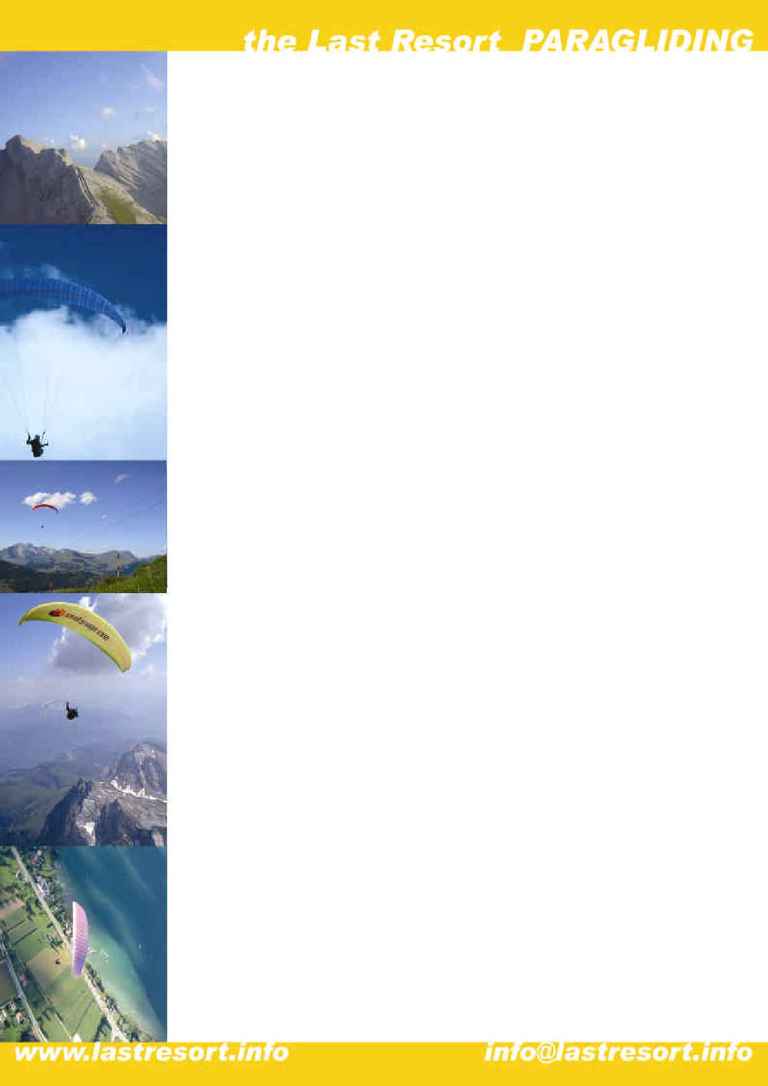
FFVL Brevet de Pilot (IPPI 4)
The first level of qualification in France is the Brevet de
Pilot which is equivalent to the BHPA Pilot rating and typi-
cally takes at least 20 days training in a school environ-
ment. This qualification allows you to free fly in most
countries in the world..
If you qualify to this level and are a member of the FFVL
then you can free fly in the UK without having a UK rating
as BHPA clubs will accept your FFVL 3
rd
party insurance.
As this qualification is accepted worldwide we will concen-
trate on IPPI level 2 & 3 qualifications and how to use
those to obtain a BHPA Novice Pilot rating.
What to do to complete training in
the UK
IPPI Level 2
Normally obtained after the 5 day initia-
tion course. You can use this card to qualify as an EPC by
visiting a UK school and getting checked out by the CFI
and then sitting and passing the EPC exam paper. You
will then be able to continue training to be a Novice Pilot
with the school.
IPPI Level 3
With this card you will be able to go for
your Novice Pilot straight away. You will need to contact a
BHPA instructor or senior club coach who will assess you
and sign you off as having the appropriate level. You
must then pass the Novice pilot written exam which can be
invigilated by the coach or instructor. To get to this level
you will normally need to do a 5 day "Initiation" course
followed by a 5 day "Perfectionment 1" (PERF 1) course
and then either another 5 day PERF 1 or a couple of
weekend PERF 1 courses.
We strongly recommend that whatever path you take you
enrol with a UK school for a few days to learn how to
handle the different flying conditions encountered in the
UK, especially strong wind take offs.
What Are the Major Differences in
the Training Schemes
As we said earlier both systems follow the FAI system but
with variations to allow for prevailing weather conditions
and the terrain.
Typically, flying in the UK and other non mountainous
areas is done on small hills in smooth dynamic lift created
by meteorological winds. This allows pilots to soar and
land back on take off. As the pilot progresses they can
find thermals mixed in with this lift which can be used to
go cross country normally downwind. This means that
the BHPA system places a lot of emphasis on launching in
windy conditions and top landing early in your flying ca-
reer.
Here in the Alps we fly from very large mountains in light
meteorological winds. This means that student pilots
spend more time in the air as you don't need to climb
back up after your little hops. You normally take a ski lift
or minibus ride to the top of a 3000' hill. A French IPPI 2
pilot will often have more airtime than a newly qualified
UK Novice pilot. Confidence is gained by flying tandem
with an instructor and on your first solo flights you will be
guided by radio. As you progress you will learn how to
soar in both thermic and dynamic (ridge) lift. As a conse-
quence of this you are unlikely to do any top landings until
the Pilot Confirme level. Reverse launching and strong
wind ground handling is mainly practiced in the landing
field when the thermic breezes get too strong to land
safely (usually for a couple of hours each afternoon).
Learning how big mountains affect localised weather and
winds is also a very important aspect of the course.
There are also few minor differences in airlaw which are
addressed by the exam paper.
How fit do I have to be?
You don't have to be a tri-athlete, but you do need to be rea-
sonably healthy.
Although in our area of France the amount of walking is
minimised - by ski lifts and vehicle transport to the take off
sites in many parts of the UK and other areas you will have
to carry your equipment (15-20kg) up a hill to take off. And if
you fly cross country you may have a walk out from where
you've landed. You have to be able to run on take off and
landing (though not far and without the weight of the glider,
which will be inflated)
Here in France the FFVL insist on a medical declaration
signed by a doctor, to confirm that you don't have any medi-
cal conditions that would be a risk for you and others whilst
flying. It's all common sense stuff e.g. can you see (with
glasses or contacts if needed), can you hear, are you sound
in wind and limb! It's possible to get one from the medical
centre here the school will drop you there after the first day of
the course.
What should I wear?
·
Boots with good ankle support (e.g. walking boots)
as you may have to occasionally run over rough
ground.
·
Gloves to protect your hands if handling the para-
glider lines in breezy conditions and also to keep
warm in the air.
·
Helmet this will be provided by the school
·
Wind proof jacket and trousers and warm layers
for flying high
·
Shorts and T Shirt etc for ground based training (it
gets very warm here)
·
High factor sunscreen and sunglasses.
OK I want to learn more!
A good place to start is with a little theory you can order
books and videos about paragliding from the BHPA shop on
the internet at http://www.bhpa.co.uk or better still give us a
call and book a course.
Contacts
BHPA http://www.bhpa.co.uk for a list of clubs and
schools in the UK and loads of other useful stuff.
FFVL http://www.ffvl.fr It's in French!!
Last Resort http://www.lastresort.info
Phone 0800 652 3977
